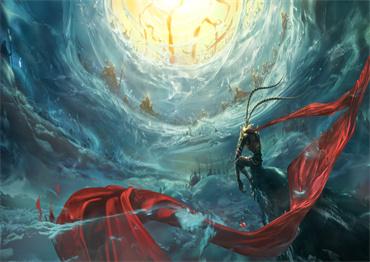The road to making Monkey King was rocky for the film’s producers and creators, but getting it funded was the hardest part. “At the time, it was tremendously difficult to fund any animation project,” Lu Wei, one of Monkey King’s producers, told NewsChina.
Lu said the Chinese animation industry in the early 2010s had not yet recovered from its 1995 downturn. With the exceptions of TV series Pleasant Goat and Big Big Wolf and Boonie Bears, no Chinese animated work had earned over 100 million yuan (US$13.9m). In the eyes of investors, animation was children’s entertainment that did not require big budgets.
“You can’t cut costs too much for animated films. If a project doesn’t get enough funding, it is likely to fail,” said Wang Shuang, an experienced animation producer. “Strictly speaking, the involvement of techniques, special effects and creativity in an animated film is on par with a live action sci-fi movie, which stands at the top of the pyramid in terms of techniques,” Wang told NewsChina.
In the eight years it took to make Monkey King, director Tian Xiaopeng exhausted all his savings and borrowed money from his parents and in-laws to keep the production going. Lu Wei signed on 10 companies as co-producers and crowdfunded 7.8 million yuan (US$1m) from 89 investors. With a total investment of 60 million yuan (US$8.3m), Lu told our reporter they initially would have been happy with breaking even.
But their efforts paid off far beyond expectations, not only in its box office performance of 956 million (US$134m), but also its impact on the whole industry. The film’s success changed the public’s long-held negative views on domestic animation.
The film sparked a vibrant online community of fans. Calling themselves zilaishui (which literarily translates to “tap water” but is a pun for “voluntary promoters”), they splashed original art, fan fiction and posters inspired by the film across social platforms. They mobilized groups to watch the film multiple times to boost its box office numbers, and even advised theaters on scheduling show times.
He Mu, a 30-year-old bank employee in Beijing, is a fan of animation, comics, games and light novels (known as AGCN culture). Like many millennials in China, she grew up watching Japanese and American cartoons. He was also a “tap water” fan.
“I saw it three times in the cinema, because I felt obligated to make more contributions to support this great work. The 3D visual effects, the characterization and storytelling are so impressive – if you were to dub it in English and tell people it was from Disney, Pixar or DreamWorks, many would believe it, because it’s that good. We felt proud that [Chinese] animators made it. The film was like a torch that rekindled a long-neglected land and preludes more splendid works to come,” He Mu said.
The film’s success encouraged other Chinese creators and producers. As Cheng Teng, director of the animated fantasy Legend of Deification (2020), told NewsChina, “Monkey King achieved a record-breaking box office of nearly 1 billion yuan (US$140m), which raised awareness of Chinese animation and encouraged more investment. As a result, lots of new projects can launch, giving more young creators the opportunity to express themselves.”
Later animated films, including Big Fish & Begonia (2016), Little Door Gods (2016), Dahufa (2017) and White Snake (2019) boosted the public’s confidence in domestic animation even more. As their appeal spread beyond its core audience, cinemas responded, scheduling more screenings.
Positive audience reception for Chinese animation reached fever pitch with another landmark 3D animated film – Nezha. As with Nezha Conquers the Dragon King (1979), the film draws on the novel Investiture of the Gods and centers on the mythological character Nezha, the disobedient boy who becomes a teenage deity after dying in battle with the Dragon King. In the film, Nezha is portrayed as a demon-child who, despite being despised and feared by the townsfolk, saves them from destruction.
Raking in 5.03 billion yuan (US$707m), Nezha helped the domestic animation market surpass imported animation for the first time since the 1990s, grabbing a market share of 65.9 percent.
According to The 2020 Chinese Animation Industry Research Report by consulting firm iResearch, the Chinese online animation industry has grown rapidly since 2015. In 2020, China had over 970,000 animation-related companies and 348 colleges offering animation programs. There were only four animation studios in China in 1990. In 1993, less than 30 animators had a college degree in animation.

 Old Version
Old Version







